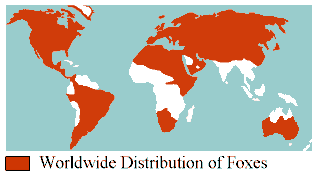
 Foxes Around the World
Foxes Around the World Besides the four (or five) North American species of fox already mentioned, sixteen other species of fox exist worldwide. There is still debate over the taxonomic classification of many foxes. The names used here are from J.W. Sheldon´s ´Wild Dogs: The Natural History of the Nondomestic Canidae´, as quoted by Rebecca Grambo in ´The Nature of Foxes´.
The best known of the remaining vulpine foxes seems to be the fennec fox, Fennecus zerda (there is some discussion about reclassifying it into the genus Vulpes). The fennec´s range stretches from the Sahara Desert in North Africa to the Arabian Peninsula.
 |
| The diminutive fennec, Fennecus zerda, is the smallest fox in the world. |
The remaining six vulpine species could also loosely be referred to as being desert foxes. These include the Bengal fox (Vulpes bengalensis) of India, the cape fox (Vulpes chama) of South Africa, the corsac fox (Vulpes corsacI) of Asia, the Tibetan sand fox (Vulpes ferrilata) of Tibet and Nepal, the pale fox (Vulpes pallida) of Saharan and sub-Saharan Africa, and the Ruppell´s fox (Vulpes ruppelli) occupying much of the same range as the fennec.
Of the remaining non-vulpine species, the bat-eared fox (Otocyon megalotis) of southern and eastern Africa is the only one not native to South America. Its claim to fame is its huge, bat-like ears which help it track down its insect prey. It also has the greatest number of teeth of any canid. Up to 80% of its diet consists of insects, which may explain why, along with the Blanford´s fox, it is one of the only species not to exhibit caching behaviour.
Finally, there are the South American foxes, which generally prove to be more dog-like than their other relatives. The largest genera is Pseudalopex and includes the culpeo or Andean wolf ( Pseudalopex culpaeus), the chilla or Argentine grey fox (Pseudalopex griseus), the pampas grey fox (Pseudalopex gymnocercus), the sechuran or Peruvian desert fox (Pseudalopex sechurae), and the hoary fox (Pseudalopex vetulus). The remaining species are the small-eared dog (Atelocynus microtis) and the crab-eating fox (Cerocyon thous). According to some sources, these two species are sometimes included into a single genus, Dusicyon.
Want to say "fox" in a different language? Foxes can be found just about everywhere and everyone seems to have a different word for them! Here´s a list compiled from various sources around the ´net, most notably the Oz Foxes Foxweb and Mike Micucci´s fox page, and also from several folks who were kind enough to write me with additions:
| Abenaki Tribe | Wokwses | German | Fuchs/ Fähe | ||||
| Albanian | Dhelpër | Ancient Greek | Alōpēx | ||||
| Arabic | Shu'Al | Hebrew | Shual | ||||
| Assiniboin Tribe | Toka no (grey fox) | Hindi | Memri | ||||
| Bahasa Indonesia | Rubah | Hungarian | Roacuteka (another reader submitted róka) |
||||
| Bengali | Sheyal | Irish Gaelic | Mauda Rua | ||||
| Bulgarian | Lisica | Italian | Volpe | ||||
| Breton | Louarn | Japanese | Kitsune | ||||
| Catalan | Guilla / Guineu | ||||||
| Cherokee Tribe | I na li (black fox) | Latin | Vulpes | ||||
| Chinese | Hu | Latvian | Lapsa | Lithuanian | Lapė | Malay | Musang | Mallorquin | Raboa |
| Choctaw Tribe | Chu la | Meneomi Tribe | Wa ko | ||||
| Creek Tribe | Tso la | Nez Perce | Ti li pe | ||||
| Norwegian | Rev | ||||||
| Croatian | Lisica | Pawne Tribe | Kiwaku (white fox) | ||||
| Czech | Lishka a.k.a. Liska :) | Polish | Lis |
||||
| Dakota Tribe | Toka la luta | Portuguese | Raposa | ||||
| Quechua | Atoq | ||||||
| Danish | ræv | Romanian | Vulpe | ||||
| Dutch | Vos | Russian | Lisita (Males: Lis / Females:Lisa) |
||||
| English | Fox / Vixen | Serbian | Lisita | ||||
| Estonian | rebane | Shawnee | Waakoce'thi | ||||
| Finnish | Kettu, Repo | Slovenian | Lis/Lisica | ||||
| Spanish | Zorro | ||||||
| French | Renard | Swedish | Räv | ||||
| Thai | Jing Johg sometimes "Hma Jing Johg" (Hma is for DOG) |
||||||
| Farsi | Rubah | Turkish | Tilki | ||||
| Urdu (Pakistan) | Lowmari | ||||||
| Gaelic | Sionnach | Welsh | (fox/vixen) Cadno/Cadnawes Llwynog/Llwynoges Madyn |
| Table of Contents |